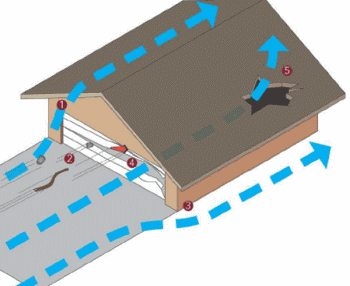PROTECT YOUR FAMILY AND HOME BY INSTALLING GARAGE DOORS THAT MEET BUILDING CODE WIND SPECIFICATIONS.
Here in Minnesota, we’ve witnessed wild winds. Trees that are mangled and twisted, roofs that are ripped and ragged, entire vehicles that are lifted and tossed through the air. Winds like that can be devastating.
We all want to feel that we are completely safe in our homes when winds start kicking in. One of the best ways to protect your family from damaging wind is by making sure your garage door is up to code when it comes to wind load requirements. Wind loads are the forces and pressures exerted on a building due to wind. These pressures act both as a positive force, pushing toward the building, as well as a negative force, or suction, pulling away from the building. In order for a garage door to meet the required code, it has to withstand a test pressure equal to 1.5 times the rated design pressure for the door for 10 seconds. In Minnesota, having a garage door that is not designed to sustain 90 mile per hour winds is not only a bad idea, it also doesn’t comply with the building code which means your insurance company may have a lot of leeway when it comes to covering wind damage claims.
Your garage entrance is one area where you want to pay special attention to ensure you comply with wind code specifications. One of the easiest ways high-speed, high-pressure wind can penetrate your home is through the widest point of access to your home, the garage door. And your garage door is a lot like a big metal kite on sliding tracks just waiting for the wind to whistle under it and push it up, or worse yet, cause it to buckle and break from intense wind, flying debris or the strain of pressure. If that happens, your entire home becomes vulnerable. The build-up of internal pressure inside your home combined with suction pressure of the storm outside your home, can result in significant damage to your home’s internal walls.
How can you prepare your garage door to be more wind-resistant? The answer is pretty simple. Reinforcement and beefing up the basics. Garage doors are made up of large panels held together with a grid of metal channels. By increasing the strength of the grid by incorporating heavier gauge steel channels, brackets and tracks plus adding additional struts, the panels become more rigid and much less likely to buckle and bend under the force of the wind. The door itself also becomes much heavier, ensuring it won’t be blown open.
Investing in a door that exceeds the minimum wind-load requirement is an ideal way to ensure that your door will be able to withstand occasional high winds.
Ask your contractor if your garage door is Minnesota State Building Code approved and can withstand 90 mph wind speeds. It should be labeled with a sticker demonstrating compliance with ANSI/DASA 108 for wind and impact resistance.
If you’re ever in doubt, call American Door Works for the answers to all your garage door questions.
THE IMPORTANCE OF HAVING DOORS DESIGNED FOR THE PROPER WIND LOAD
1.High winds first create pressure against the windward side of the structure.
2.During high wind events, debris can become powerful projectiles that can damage the garage door, reducing the door's ability to protect the home against damaging winds.
3.Pressure increases when the wind moves around the corner and down the side of the building.
4.Garage doors with no reinforcement can buckle under the pressure, giving the high winds access to the interior of the structure.
5.This often results in the roof members and wall panels being blown apart, allowing rain, wind and debris to have easy access inside.

